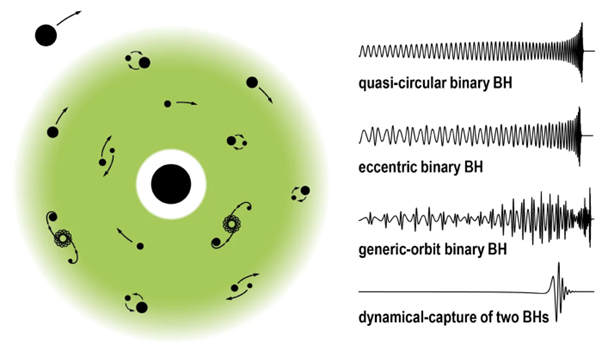Maarten van de Meent awarded ERC Synergy grant
Maarten van de Meent, current member of the Strong Group at NBI, is one of the four principal investigators of the GWSky project, which was awarded 12 million euros by the European Research Council to investigate gravitational waves.

Existing and future gravitational-wave detectors will observe signals so precisely that they will be able to detect possible deviations from Einstein’s theory of relativity and the standard model of particle physics. To fully exploit this unique instrumental capability, fundamental advances are needed in the theoretical description of black holes, the gravitational waves they emit, their cosmic environment, and physics beyond the standard model. Providing this necessary theoretical framework is the aim of the project GWSky, which was awarded a total of 12 million euros over the next six years by the European Research Council.
The ERC Synergy grant involves four nodes, the Center of Gravity at the Niels Bohr Institute in Copenhagen, the University of California Los Angeles, the Max Planck Institute for Gravitational Physics in Potsdam, and SISSA (Scuola Internazionale Superiore di Studi Avanzati) in Trieste.
The aim of the project, titled ‘Making Sense of the Unexpected in the Gravitational-Wave Sky’ (GWSky), is to use gravitational-wave measurements by existing and future observatories on Earth and in space as precision laboratories for fundamental physics, cosmology and astrophysics. This includes the current detectors of the LIGO-Virgo-KAGRA collaboration as well as the future ground-based observatories Cosmic Explorer and Einstein Telescope, and the space-based LISA detector.
“Upgrades to current gravitational-wave observatories and entirely new facilities are promising to revolutionize physics and astrophysics with a flood of precision data from the mergers of black holes throughout cosmic history. However, this can only be realized, if we understand the nuances in what these signals are telling us”, explains Maarten van de Meent, one of the PI’s of the project alongside Enrico Barausse (SISSA), Zvi Bern (University of California Los Angeles), and Alessandra Buonanno (Max Planck Institute for Gravitational Physics). “Luckily, Nature has been kind and black holes, despite their enigmatic nature, are among the simplest macroscopic objects in the Universe. This puts learning their language purely from principles, while challenging, within reach of theoretical physicists like ourselves,” continues Maarten van de Meent.
The GWSky node in Copenhagen will be hosted by the ‘Center of Gravity’, a new DNRF Center of Excellence at the Niels Bohr Institute, which was awarded funding last month. Together these new funding opportunities will help consolidate even further gravitational physics as one of the internationally recognized strengths of the Niels Bohr Institute at the University of Copenhagen.
About ERC Synergy Grants
The European Research Council awards Synergy Grants for scientifically excellent research projects through a complex and competitive selection process. Grants are awarded for a period of six years and are generally worth up to 10 million euros. Additional funding can be requested for large-scale equipment relevant to the project. Funding is available for projects involving two to four Principal Investigators (PIs). In the current selection round, the ERC is funding 56 projects out of 540 evaluated research proposals from all scientific disciplines. This corresponds to a success rate of 10.4 percent.
The GWSky project will receive a total of 11.98 million euros, of which 2.86 million euros will go to the Niels Bohr Institute at the University of Copenhagen.
The three other nodes and the researchers involved in this ERC Synergy Grant are:
- Enrico Barausse, SISSA (Scuola Internazionale Superiore di Studi Avanzati), Trieste, Italy. Press release SISSA
- Zvi Bern from the University of California, Los Angeles, USA. Press release UCLA
- Alessandra Buonanno, Max Planck Institute for Gravitational Physics (Albert Einstein Institute), Potsdam, Germany. Press release Max Planck Institute, AEI
